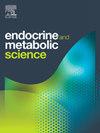Effectiveness of radioactive iodine (RAI) and its associations with different factors in people presenting with hyperthyroidism
Q3 Medicine
引用次数: 0
Abstract
Background
Radioactive iodine (RAI) is the important modality to treat Hyperthyroidism. Successful treatment is determined by development of euthyroidism and / or Hypothyroidism within 6 months of radioactive iodine treatment. The aim of this study was to find out the outcome of RAI treatment and its association with factors like age, gender various etiologies of hyperthyroidism and baseline TSH, FT4 in our population.
Methods
This retrospective study was conducted at KIRAN from January 2018 to June 2020. A total of 199 participants with complete data were recruited in study after IRB approval. Demographic details, age, gender, the underlying cause of hyperthyroidism Graves' disease, toxic multinodular goiter, toxic nodule, were obtained from medical records along with baseline FT4 & TSH. A fixed dose of 15mci of radioactive iodine was given to all patients and TSH and FT4 were measured at 6 weeks 3, 6, and 12 months. Data was analyzed by SPSS version 20.
Results
In our study 77.9 % were females, 22.1 % males, mean age was 41.32 ± 0.99 years, 74.4 % had Graves’ disease, whereas 15 % participants had solitary toxic nodule & toxic multinodular goiter. Post RAI TSH target was achieved earlier compared to FT4. Outcome of RAI treatment in patients with Graves’ disease and toxic nodule revealed statistically significant and early result. Females revealed significant improvement at 6 months in both biochemical markers i-e TSH and FT4 compared to males, however, the FT4 was statistically significant early in elderly participants. Successful treatment was noticed in 75.6 % at 6 &12 months.
Conclusion
Fixed dose RAI treatment achieved a 75.6 % success rate at 6 & 12 months, with prompt response noted in female gender, Graves’ disease and toxic nodules. Biochemical (TSH + FT4) improvement was faster in Females, while FT4 normalized earlier in elderly patients and overall TSH levels stabilized before FT4 levels, confirming RAI's effectiveness.
放射性碘(RAI)在甲亢患者中的有效性及其与不同因素的关系
背景放射性碘(RAI)是治疗甲状腺功能亢进症的重要方法。治疗成功与否取决于放射性碘治疗后 6 个月内是否出现甲状腺功能亢进和/或甲状腺功能减退。本研究旨在找出 RAI 治疗的结果及其与年龄、性别、甲亢的各种病因和基线 TSH、FT4 等因素的关系。方法这项回顾性研究于 2018 年 1 月至 2020 年 6 月在 KIRAN 进行。经 IRB 批准后,共招募了 199 名数据完整的参与者参与研究。研究人员从病历中获取了人口统计学细节、年龄、性别、甲状腺功能亢进的根本原因格雷夫斯病、毒性多结节性甲状腺肿、毒性结节以及基线 FT4 & TSH。所有患者都服用了固定剂量的 15mci 放射性碘,并在 6 周、3 个月、6 个月和 12 个月时测量 TSH 和 FT4。研究结果77.9%的患者为女性,22.1%为男性,平均年龄为(41.32 ± 0.99)岁,74.4%的患者患有巴塞杜氏病,15%的患者患有单发毒性结节和毒性多结节性甲状腺肿。与FT4相比,RAI后TSH更早达到目标。对患有巴塞杜氏病和毒性结节的患者进行 RAI 治疗的结果显示,在统计学上有显著的早期疗效。与男性相比,女性患者的促甲状腺激素(TSH)和绒毛膜促性腺激素(FT4)在6个月后的生化指标均有明显改善,但在老年患者中,FT4的改善较早。结论固定剂量 RAI 治疗在 6 个月和 12 个月时的成功率为 75.6%,女性、巴塞杜氏病和毒性结节患者的反应较快。女性患者的生化指标(TSH + FT4)改善更快,而老年患者的 FT4 正常化更早,总体 TSH 水平先于 FT4 水平趋于稳定,这证实了 RAI 的有效性。
本文章由计算机程序翻译,如有差异,请以英文原文为准。
求助全文
约1分钟内获得全文
求助全文
来源期刊

Endocrine and Metabolic Science
Medicine-Endocrinology, Diabetes and Metabolism
CiteScore
2.80
自引率
0.00%
发文量
4
审稿时长
84 days
 求助内容:
求助内容: 应助结果提醒方式:
应助结果提醒方式:


